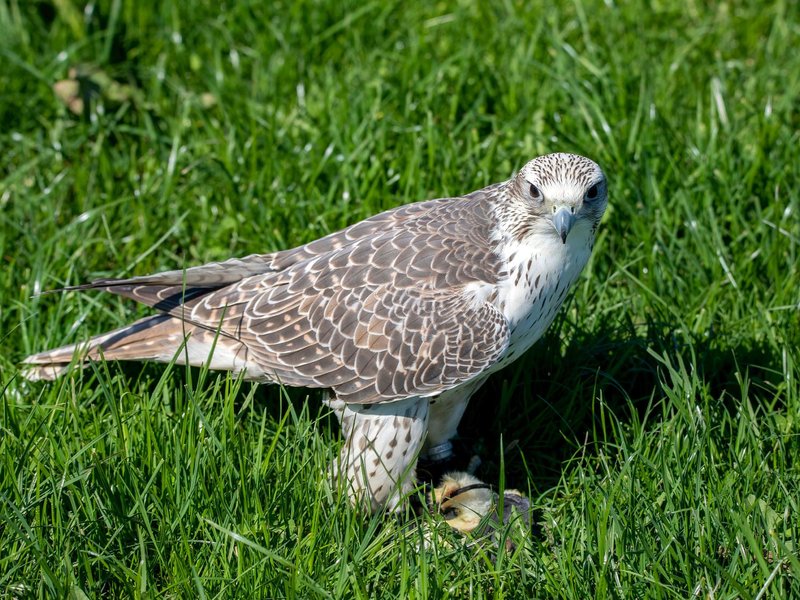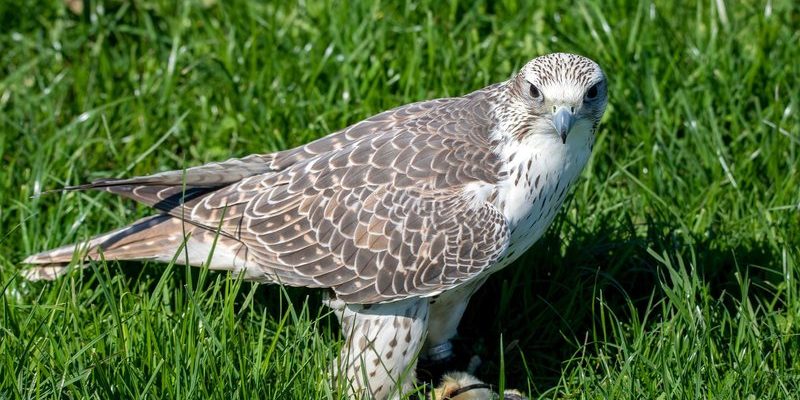
What Do Gyrfalcons Eat?
Gyrfalcons are true opportunists when it comes to food. Their diets can vary widely depending on their habitat and the season. Generally, they thrive on a mix of small mammals, birds, and even fish. This flexibility allows them to adapt to changing conditions in their Arctic and subarctic environments.
- Birds: Gyrfalcons are known to hunt various birds, including ptarmigans, ducks, and seabirds. Their speed and agility in the air make them formidable avian predators.
- Mammals: In some habitats, they may feast on small mammals like rabbits or hares, especially when birds are scarce.
- Fish: Occasionally, Gyrfalcons will target fish, particularly in coastal areas where they can dive to catch these slippery meals.
By having a diverse diet, Gyrfalcons keep themselves well-nourished and ready to tackle the challenges of their environment, whether that means hunting in the icy tundra or along rocky cliffs.
How Gyrfalcons Hunt: Speed and Strategy
When it comes to hunting, Gyrfalcons are the athletes of the bird world. Their hunting strategies are as varied as their diet. Typically, they rely on their incredible speed and sharp eyesight to locate prey from high above. These birds can reach speeds of over 50 mph (80 kph) during a stoop, or hunting dive. This makes them one of the fastest birds in the world.
What’s fascinating is how they combine skills to ensure a successful hunt. A Gyrfalcon often starts by soaring high above the ground, scanning the area for movement. Once they spot potential prey, they swoop down, using the element of surprise to catch their target off guard. This method can be likened to a football player dodging defenders to score a touchdown—a mix of speed, timing, and strategy.
Use of Terrain and Weather
Gyrfalcons are clever about using their surroundings to their advantage. They often hunt in areas where they can blend into the landscape, like rocky cliffs or snow-covered ground. The white plumage of some Gyrfalcons can help them camouflage well against the snow, making it easier to sneak up on unsuspecting prey.
Weather also plays a significant role in their hunting strategy. During windy days, Gyrfalcons may use strong gusts to their benefit, gliding effortlessly as they search for food. Conversely, during calm weather, they might rely more on their speed and stealth to catch meals. Each decision they make incorporates a blend of instinct and environmental awareness—much like how we adapt our plans based on the weather forecast.
Hunting Techniques of the Gyrfalcon
The techniques Gyrfalcons use are dynamic and can vary slightly between individual birds or regions. Here are some common techniques employed by these incredible hunters:
- Surprise Attacks: As mentioned, they often rely on their ability to remain hidden until the last moment, which makes them efficient at surprising their prey.
- Chase Hunts: Sometimes, they’ll pursue a bird over a long distance, using their speed to outmaneuver slower birds.
- Ground Hunts: When prey is out of reach in the air, Gyrfalcons can also hunt animals like rabbits or ground-nesting birds by diving down quickly or using stealth to approach unnoticed.
Each of these techniques showcases the Gyrfalcon’s adaptability and skill, further solidifying its reputation as a master hunter in the avian world.
Seasonal Diet Changes
Just like we might change our meals with the seasons, Gyrfalcons also adjust their diets based on what’s available throughout the year. In the long, harsh Arctic winter, food can be scarce, leading these birds to rely more on smaller mammals or even scavenging from larger predators.
As spring rolls in and birds begin to migrate back to their breeding grounds, Gyrfalcons eagerly shift their focus to avian prey. This adaptability to seasonal changes ensures that they can sustain themselves regardless of the time of year. It’s a bit like how we might stock up on hearty stews in winter and opt for lighter salads in summer.
The Role of Gyrfalcons in Their Ecosystem
Beyond just being fascinating predators, Gyrfalcons play a crucial role in their ecosystems. By controlling the populations of their prey, they help maintain a balanced environment. Imagine a world without Gyrfalcons; bird populations could explode, leading to overgrazing of vegetation and an imbalance in the ecosystem.
Additionally, Gyrfalcons can also indicate the health of their environment. As top predators, they are vulnerable to changes in their habitat, such as pollution or climate change. Their presence signals a robust ecosystem, while their decline may point to broader environmental issues that need attention.
Conservation and Future of Gyrfalcons
Unfortunately, while Gyrfalcons are skilled hunters, they face threats from habitat loss, climate change, and human interference. Conservation efforts are essential to protect their habitats and ensure these magnificent birds continue to thrive.
Organizations and researchers are actively working to monitor Gyrfalcon populations and implement measures to safeguard their environments. By raising awareness and taking action, we can help ensure that future generations will also get to witness these stunning hunters in action—soaring through the skies with grace and power.
In conclusion, the Gyrfalcon is not just a bird of prey; it’s a symbol of resilience and adaptability in the face of nature’s challenges. From its complex diet to its unique hunting strategies, every aspect of this incredible species is a testament to the wonders of wildlife. So next time you think of a Gyrfalcon, remember it’s not just about its beauty—it’s about the intricate role it plays in our world.

